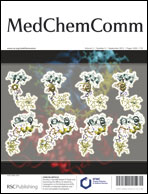Discovery of a new class of dithiocarbamates and rhodanine scaffolds as potent antifungal agents: synthesis, biology and molecular docking†
Abstract
Drug resistance to established antifungals such as azole derivatives (fluconazole and ketoconazole) is driving the rise in global mortality due to fungal infection. Identification of new molecular entities structurally unrelated to these may represent a valid strategy to overcome resistance to currently available drugs. In an effort to develop highly potent antifungal agents, we report herein a series of 27 compounds of dithiocarbamate and the rhodanine molecules containing pyridine moiety and their antifungal activity. Among the synthesized compounds, several analogues have shown potent antifungal activity. The potent compounds against Candida albicans strain were further tested for in vitro anticandidal activity and amphotericin B-resistant strain of Candida albicans. Several derivatives 4a–f, 6, and 7k–n were found to be more effective (MIC = 0.39 – 3.12 μg mL−1) against Candida albicans MTCC183 and further these compounds, except 4e, 4f, and 7m, showed significant activity against amphotericin B-resistant strain of Candida albicans than that of fluconazole. Moreover, these analogues did not exhibit any toxicity up to MIC 3.12 μg mL−1 against mammalian cell line L929. A molecular docking study was undertaken to understand the mode of action of the active compounds towards prospective target lanosterol 14α-demethylase (CYP-51).


 Please wait while we load your content...
Please wait while we load your content...